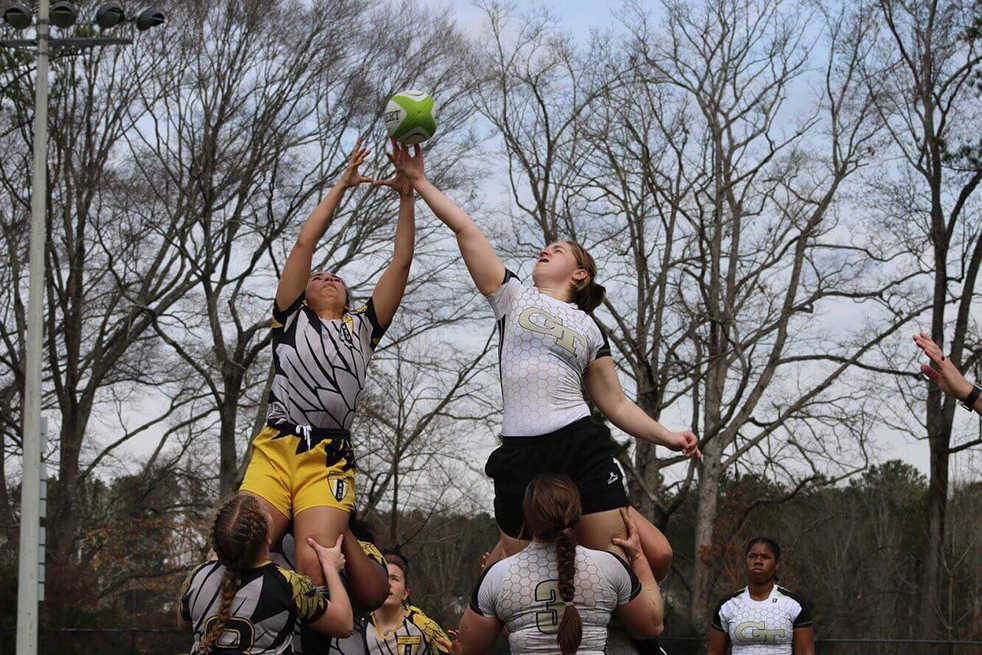Sarah Violante walks in the room with a noticeable limp, one of her knees enveloped in an implement that seems to be a cross between a brace and athletic tape. How did she get hurt?
“I was rucking a girl,” she says.
Thus begins an investigation into the hard-hitting, fast-paced, frankly violent sport that is women’s rugby. Rucking turns out to be a central aspect of the game: the way the ball is retrieved from the middle of a cluster of players using nothing but feet.
“When you ruck, you put your shoulder into another girl’s shoulder, and the ball’s beneath you,” she explains. Both teams fight to push the other off the ball. Violante, resisting the offensive efforts of the University of Georgia’s team, caught the brunt of a collision.
At a first glance at a live rugby match — or a YouTube clip of one — the sport looks a great deal like American football. Yes, it is more free-form; there do not seem to be pre-set plays nor are there 30-second breaks between short sprints. But players carry an oddly-shaped ball downfield and deftly pass it to teammates before being enveloped in a suffocating tackle. It is not difficult to see the roots of the United States’ most popular sport.
Yet rugby has not cultivated the foothold in America that it enjoys in other former British commonwealth countries such as New Zealand or Australia; the Philadelphia Fight, a three-time national champion in the USA Rugby League, counts less than 3,000 followers on Twitter — so it is reasonable to wonder not only why players like Violante decided to play rugby but how they even found it.
For Violante, the introduction to the sport was good fortune — as a first-semester freshman, she was taking a weightlifting-based health class and saw a classmate at the CRC with a Georgia Tech Women’s Rugby windbreaker. “So I just signed up for it and went to a practice, she said.”
Serendipitous as this path may seem, it is also largely the norm. The vast majority of women’s rugby players on the team had never competed before setting foot on campus. “I can’t think of anyone who has played it before [coming to Tech],” Violante says. So, while teams such as club tennis and club soccer operate under the assumption that their team members understand the rules of their respective sports, women’s rugby does not take that for granted. Practices are important, but the only way to learn the sport is to participate in a game.
“It’s better to go out and play, in terms of understanding rules and how the game flows, than just doing practice — like doing hits and stuff,” she argues.
Still, it is difficult to imagine that simple gameplay is enough for a beginner to understand the complex, alien terminology associated with a new sport. A quick glance at the team’s website shows that a number of the members play positions whose names have little to do with their functions. Violante plays fullback, wing and inside/outside center. Anna Harris plays eightman and lock. Each of these positions refers to a specialized role on the field that a player must execute.
Eightman, Violante explains, is “typically someone who is tall and sturdy, at the back of scrum.” The hooker “rake[s] the ball out [of the scrum].” The prop is “the strongest”, a player on the front line charged with driving the other team’s props off the ball. In this vibrant world, Violante and her teammates seem right at home.
The game takes a physical toll. Once a player is substituted out, she is not allowed to return. Frequently, the question coaches ask is, “Are you hurt? Or are you injured?” Given how physical the sport is, injury is almost a certainty, as is playing through it. Violante says she has even played through an injury that later required stitches, pointing to a scar. Bumps and bruises accumulate over the course of a game so physical, and playing through requires a high degree of durability.
“I can count on one hand how many times I’ve had to come off,” Violante says. The key managing your pain? Practicing the technique associated with falling. “Your knees should be the first things to hit the ground. When you’re falling down, you really shouldn’t put your hands out or anything. If you’re falling to the ground head-first, of course you’re going to get injured.” It also helps that rugby rules require that the tackler go to the ground with the player being tackled, ensuring that dangerous actions such as clotheslining are prohibited.
The team is still in the midst of its fall “friendly” season, where the matches count not for league standings but for experience. Scheduling a fall opponent is as simple as checking that the two teams’ schedules align and that a field can be booked. In the spring, sanctioned competitions begin. Here, Tech finds itself competing with other club programs like its own as well as with Division I teams. Violante’s fondest memory, interestingly enough, is a lopsided defeat at the hands of Life University, considered one of the best teams in the country. For a number of the young players, it was a valuable chance to acclimate to the highest level of the sport.
“I don’t remember what the final score was. It was horrible. But as a fullback, it was a really memorable game for me because I had a lot of good hits on defense,” she says.
A few years ago, the team barely had enough members to field one competitive unit. Now, they have a practice squad. “It’s a new era now,” she says. A new “family” has taken over Georgia Tech Women’s Rugby, and they have their eyes on unprecedented success. Is a national championship in the cards? “I think at the rate we’re growing at now, really from a numbers and commitment standpoint, it’s possible.”
